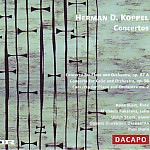These three concertos span 40 years of Herman Koppel’s long creative career, from the early 1930s to the early 1970s. Like many 20th century composers his style grew more pithy and acerbic (that is, atonal) as he grew older, and if this is what the future holds in store for you, and you feel obliged to write a flute concerto, then later is probably better. For some reason, the flute responds well to a relatively high level of dissonance (think Ibert’s concerto), while the instrument’s bright timbre and agility give the music a nice tart quality. And although this 17-minute piece is for all intents and purposes atonal, it also is frankly melodic, even arrestingly so, with clearly recognizable tunes and gestures. Easy listening it may not be, but pleasant listening it certainly is.
Next up is the Cello Concerto from the 1950s–a flat-out masterpiece that deserves much wider exposure. The writing is virtuosic and brilliant, the thematic material memorably distinctive, and I can’t imagine any cellist (or audience) not finding the piece a rewarding experience. Koppel’s Second Piano Concerto (out of four) is the earliest work here, and a curious one too. Koppel himself had reservations about it, which he later dismissed, but its emphasis on chunky rhythmic ostinatos combined with the unflashy piano writing means that it’s never likely to be popular with soloists. It also sounds a bit long for its material, though audiences should have no problem enjoying its spiky harmonic idiom or its abundant (indeed relentless) energy.
For the most part the performances are quite good. Flutist Rune Most and pianist Ulrich Staerk fare best, while cellist Michaela Fukacova plays with evident gusto but also with some sour intonation in her upper register. Still, with very sympathetic support from the Odense orchestra under Paul Mann, all of this music makes a favorable impression, and even a few moments of iffy intonation can’t hide the fact that the Cello Concerto really is a major discovery.
































